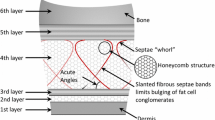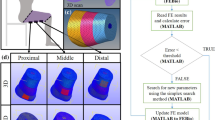Abstract
The purpose of this study was to characterize the viscoelastic behavior of diabetic and non-diabetic plantar soft tissue at six ulcer-prone/load-bearing locations beneath the foot to determine any changes that may play a role in diabetic ulcer formation and subsequent amputation in this predisposed population. Four older diabetic and four control fresh frozen cadaveric feet were each dissected to isolate plantar tissue specimens from the hallux, first, third, and fifth metatarsals, lateral midfoot, and calcaneus. Stress relaxation experiments were used to quantify the viscoelastic tissue properties by fitting the data to the quasi-linear viscoelastic (QLV) theory using two methods, a traditional frequency-insensitive approach and an indirect frequency-sensitive approach, and by measuring several additional parameters from the raw data including the rate and amount of overall relaxation. The stress relaxation response of both diabetic and non-diabetic specimens was unexpectedly similar and accordingly few of the QLV parameters for either fit approach and none of raw data parameters differed. Likewise, no differences were found between plantar locations. The accuracy of both fit methods was comparable, however, neither approach predicted the ramp behavior. Further, fit coefficients varied considerably from one method to the other, making it hard to discern meaningful trends. Future testing using alternate loading modes and intact feet may provide more insight into the role that time-dependent properties play in diabetic foot ulceration.







Similar content being viewed by others
References
Abramowitch, S. D., and S. L. Woo. An improved method to analyze the stress relaxation of ligaments following a finite ramp time based on the quasi-linear viscoelastic theory. J. Biomech. Eng. 126:92–97, 2004.
Bennett, M. B., and R. F. Ker. The mechanical properties of the human subcalcaneal fat pad in compression. J. Anat. 171:131–138, 1990.
Bilston, L. E., and L. E. Thibault. The mechanical properties of the human cervical spinal cord in vitro. Ann. Biomed. Eng. 24:67–74, 1996.
Bonifasi-Lista, C., S. P. Lake, M. S. Small, and J. A. Weiss. Viscoelastic properties of the human medial collateral ligament under longitudinal, transverse and shear loading. J. Orthop. Res. 23:67–76, 2005.
CDCP. National Diabetes Fact Sheet: General Information and National Estimates on Diabetes in the United States. Atlanta, GA: Centers for Disease Control and Prevention, 2007.
Chen, R.-J., C.-C. K. Lin, and M.-S. Ju. In situ biomechanical properties of normal and diabetic nerves: an efficient quasi-linear viscoelastic approach. J. Biomech. 43:1118–1124, 2010.
Cheung, Y. Y., M. Doyley, T. B. Miller, F. Kennedy, F. Lynch, Jr., J. S. Wrobel, K. Paulson, and J. Weaver. Magnetic resonance elastography of the plantar fat pads: preliminary study in diabetic patients and asymptomatic volunteers. J. Comput. Assist. Tomogr. 30:321–326, 2006.
Cowley, M. S., E. J. Boyko, J. B. Shofer, J. H. Ahroni, and W. R. Ledoux. Foot ulcer risk and location in relation to prospective clinical assessment of foot shape and mobility among persons with diabetes. Diabetes Res. Clin. Pract. 82:226–232, 2008.
Doehring, T. C., E. O. Carew, and I. Vesely. The effect of strain rate on the viscoelastic response of aortic valve tissue: a direct-fit approach. Ann. Biomed. Eng. 32:223–232, 2004.
Duenwald, S. E., R. Vanderby, and R. S. Lakes. Constitutive equations for ligament and other soft tissue: evaluation by experiment. Acta Mech. 205:23–33, 2009.
Elliott, D. M., P. S. Robinson, J. A. Gimbel, J. J. Sarver, J. A. Abboud, R. V. Iozzo, and L. J. Soslowsky. Effect of altered matrix proteins on quasilinear viscoelastic properties in transgenic mouse tail tendons. Ann. Biomed. Eng. 31:599–605, 2003.
Fung, Y. C. Biomechanics: Mechanical Properties of Living Tissues (2nd ed.). New York: Springer, 1993.
Funk, J. R., G. W. Hall, J. R. Crandall, and W. D. Pilkey. Linear and quasi-linear viscoelastic characterization of ankle ligaments. J. Biomech. Eng. 122:15–22, 2000.
Gefen, A., M. Megido-Ravid, M. Azariah, Y. Itzchak, and M. Arcan. Integration of plantar soft tissue stiffness measurements in routine MRI of the diabetic foot. Clin. Biomech. 16:921–925, 2001.
Gimbel, J. A., J. J. Sarver, and L. J. Soslowsky. The effect of overshooting the target strain on estimating viscoelastic properties from stress relaxation experiments. J. Biomech. Eng. 126:844–848, 2004.
Harris, M. I., R. Klein, T. A. Welborn, and M. W. Knuiman. Onset of NIDDM occurs at least 4–7 yr before clinical diagnosis. Diabetes Care 15:815–819, 1992.
Hingorani, R. V., P. P. Provenzano, R. S. Lakes, A. Escarcega, and R. Vanderby, Jr. Nonlinear viscoelasticity in rabbit medial collateral ligament. Ann. Biomed. Eng. 32:306–312, 2004.
Hsu, T. C., Y. S. Lee, and Y. W. Shau. Biomechanics of the heel pad for type 2 diabetic patients. Clin. Biomech. 17:291–296, 2002.
Hsu, C. C., W. C. Tsai, T. Y. Hsiao, F. Y. Tseng, Y. W. Shau, C. L. Wang, and S. C. Lin. Diabetic effects on microchambers and macrochambers tissue properties in human heel pads. Clin. Biomech. 24:682–686, 2009.
Hsu, C. C., W. C. Tsai, Y. W. Shau, K. L. Lee, and C. F. Hu. Altered energy dissipation ratio of the plantar soft tissues under the metatarsal heads in patients with type 2 diabetes mellitus: a pilot study. Clin. Biomech. 22:67–73, 2007.
Hsu, T. C., C. L. Wang, Y. W. Shau, F. T. Tang, K. L. Li, and C. Y. Chen. Altered heel-pad mechanical properties in patients with Type 2 diabetes mellitus. Diabet. Med. 17:854–859, 2000.
Huang, C. Y., V. M. Wang, E. L. Flatow, and V. C. Mow. Temperature-dependent viscoelastic properties of the human supraspinatus tendon. J. Biomech. 42:546–549, 2009.
Iatridis, J. C., L. A. Setton, M. Weidenbaum, and V. C. Mow. The viscoelastic behavior of the non-degenerate human lumbar nucleus pulposus in shear. J. Biomech. 30:1005–1013, 1997.
Isakov, E., N. Budoragin, S. Shenhav, I. Mendelevich, A. Korzets, and Z. Susak. Anatomic sites of foot lesions resulting in amputation among diabetics and non-diabetics. Am. J. Phys. Med. Rehabil. 74:130–133, 1995.
Klaesner, J. W., M. K. Hastings, D. Zou, C. Lewis, and M. J. Mueller. Plantar tissue stiffness in patients with diabetes mellitus and peripheral neuropathy. Arch. Phys. Med. Rehabil. 83:1796–1801, 2002.
Kwan, M. K., T. H. Lin, and S. L. Woo. On the viscoelastic properties of the anteromedial bundle of the anterior cruciate ligament. J. Biomech. 26:447–452, 1993.
Lavery, L. A., S. A. Vela, J. G. Fleischli, D. G. Armstrong, and D. C. Lavery. Reducing plantar pressure in the neuropathic foot. A comparison of footwear. Diabetes Care 20:1706–1710, 1997.
Ledoux, W. R., and J. J. Blevins. The compressive material properties of the plantar soft tissue. J. Biomech. 40:2975–2981, 2007.
Ledoux, W. R., and H. J. Hillstrom. The distributed plantar vertical force of neutrally aligned and pes planus feet. Gait Posture 15:1–9, 2002.
Ledoux, W. R., D. F. Meaney, and H. J. Hillstrom. A quasi-linear, viscoelastic, structural model of the plantar soft tissue with frequency-sensitive damping properties. J. Biomech. Eng. 126:831–837, 2004.
Miller-Young, J. E., and N. A. Duncan. Material Properties of the Human Calcaneal Fat Pad in Compression: Validation Experiments. 4th World Congress of Biomechanics, Calgary, AB, 2002.
Miller-Young, J. E., N. A. Duncan, and G. Baroud. Material properties of the human calcaneal fat pad in compression: experiment and theory. J. Biomech. 35:1523–1531, 2002.
Natali, A. N., C. G. Fontanella, and E. L. Carniel. Constitutive formulation and analysis of heel pad tissues mechanics. Med. Eng. Phys. 32:516–522, 2010.
Pai, S., and W. R. Ledoux. The compressive mechanical properties of diabetic and non-diabetic plantar soft tissue. J. Biomech. 43:1754–1760, 2010.
Pai, S., and W. R. Ledoux. The effect of target strain error on plantar tissue stress. J. Biomech. Eng. 132:071001, 2010.
Pena, E., J. A. Pena, and M. Doblare. On modelling nonlinear viscoelastic effects in ligaments. J. Biomech. 41:2659–2666, 2008.
Piaggesi, A., M. Romanelli, E. Schipani, F. Campi, A. Magliaro, F. Baccetti, and R. Navalesi. Hardness of plantar skin in diabetic neuropathic feet. J. Diabetes Complicat. 13:129–134, 1999.
Provenzano, P. P., R. S. Lakes, D. T. Corr, and R. Vanderby, Jr. Application of nonlinear viscoelastic models to describe ligament behavior. Biomech. Model. Mechanobiol. 1:45–57, 2002.
Puso, M. A., and J. A. Weiss. Finite element implementation of anisotropic quasi-linear viscoelasticity using a discrete spectrum approximation. J. Biomech. Eng. 120:62–70, 1998.
R Development Core Team. R: A Language and Environment for Statistical Computing. Vienna, Austria: R Foundation for Statistical Computing, 2009.
Rousseau, E. P., A. A. Sauren, M. C. van Hout, and A. A. van Steenhoven. Elastic and viscoelastic material behaviour of fresh and glutaraldehyde-treated porcine aortic valve tissue. J. Biomech. 16:339–348, 1983.
Sauren, A. A., and E. P. Rousseau. A concise sensitivity analysis of the quasi-linear viscoelastic model proposed by Fung. J. Biomech. Eng. 105:92–95, 1983.
Schmid, H., M. P. Nash, A. A. Young, and P. J. Hunter. Myocardial material parameter estimation—a comparative study for simple shear. J. Biomech. Eng. 128:742–750, 2006.
Thomopoulos, S., G. R. Williams, J. A. Gimbel, M. Favata, and L. J. Soslowsky. Variation of biomechanical, structural, and compositional properties along the tendon to bone insertion site. J. Orthop. Res. 21:413–419, 2003.
Woo, S. L., M. A. Gomez, and W. H. Akeson. The time and history-dependent viscoelastic properties of the canine medial collateral ligament. J. Biomech. Eng. 103:293–298, 1981.
Woo, S. L., B. R. Simon, S. C. Kuei, and W. H. Akeson. Quasi-linear viscoelastic properties of normal articular cartilage. J. Biomech. Eng. 102:85–90, 1980.
Acknowledgments
This study was funded by the National Institutes of Health grant 1R01 DK75633-03 and the Department of Veterans Affairs, RR&D Service grant A4843C. The authors would also like to thank Jane Shofer, M.S., for the statistical analysis, Michael Fassbind, M.S., for equipment design, and Paul Vawter for assisting with data analysis.
Author information
Authors and Affiliations
Corresponding author
Additional information
Associate Editor Peter E. McHugh oversaw the review of this article.
Rights and permissions
About this article
Cite this article
Pai, S., Ledoux, W.R. The Quasi-Linear Viscoelastic Properties of Diabetic and Non-Diabetic Plantar Soft Tissue. Ann Biomed Eng 39, 1517–1527 (2011). https://doi.org/10.1007/s10439-011-0263-z
Received:
Accepted:
Published:
Issue Date:
DOI: https://doi.org/10.1007/s10439-011-0263-z




